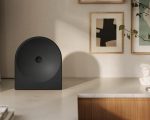
- Two 15W drivers in a very small cube-style case
- Digital signal processing adjusts speaker output to emulate distance
- Available from Japan for roughly $255
One of the key things about stereo sound is that to get it, you need decently spaced stereo speakers. And that’s a problem for small devices where you can’t space the speakers out enough to get a large stereo sound stage. Manufacturers have come up with lots of tricks to make small speakers sound bigger, but to the best of my knowledge Pavé’s little speaker is unique: it’s got a gyroscope inside.
The Cear Pavé is an exceptionally small speaker, just over three and a half inches in each dimension, that promises to sound much bigger, with a stereo image close to what you’d hear from a traditional twin-speaker setup. And to do that, it uses clever technology to mess with your brain.
Pychoacoustics, qu’est-ce que c’est?
According to Notebookcheck.net, The speaker uses a combination of digital signal processing and what’s known as psychoacoustics, which is the study of how we perceive sound.
We don’t just hear sound directly. We hear its reflections and its vibrations too, and with a bit of technological trickery, you can adjust the output of speakers to emulate that – so for example by slightly adjusting the timing of certain frequencies to your speaker drivers you can replicate the short delay that would come from having a speaker placed a little further away from you.
In this speaker the processing is carried out by a Qualcomm S5 Gen 2 chip and then delivered via twin 15-watt drivers to deliver a much larger-sounding stereo sound than you’d expect from such a small speaker.
The Pavé isn’t the only speaker to do this, of course: Sony‘s Reality Audio, and similar systems from other firms, also use digital signal processing to make their speakers sound bigger. But it also contains the aforementioned gyroscope to detect the movement and positioning of the speaker and to adjust its stereo effect accordingly.
Here’s how it works, according to Cear’s patent: Its “sound processing device includes an equalizer that tunes the frequency characteristic so that a frequency characteristic of the sound wave listened in a second environment replicates the frequency characteristic of a sound wave listened in a first environment.” So there you have it. Qualcomm has a good explainer on its developer blog too.
I haven’t heard this particular speaker but I’d like to: we’ve come a long way from the frankly crap “virtual stereo” and “virtual surround” of early Bluetooth speakers and soundbars; when it’s done well, digital signal processing can produce quite startling results.








